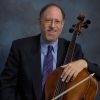
The Joy of Feuillard – A Sequential Approach to Teaching Bow Technique (Part 22 – Feuillard No. 34 – Variations #20-25)
Robert Jesselson
The variations this week will continue the work with detaché bowings and string crossings. I also addressed bow changes and some more bow speed exercises. Variation #25 will again work with wave motions, though faster and in triplets. I also discussed how to approach vibrato while doing the string crossings.
Variation #20:
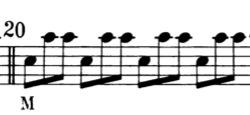
Because they are supposed to be played in the middle of the bow, variations #20-24 all require using the lower arm for the detaché stroke and the upper arm for the string crossings. These variations are great for developing a good, resonant detaché. But it usually takes some time to train the ear for the right sound, and the body for the right motions. A good detaché requires constant arm weight and steady bow speed. There should be no “pumping” of the sound and no accents. Our goal is a “ringy” sound that helps connect the strokes.
Variation #21:
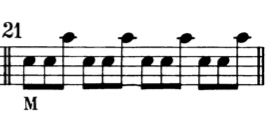
I worked with Tristan a bit on his vibrato with this variation. Developing a good vibrato is an on-going project and a “work in process”. I teach vibrato through a large variety of exercises that focus on width and speed, as well as the physical motions involved. I identify two major vibrato movements: what I call “rotational” and “longitudinal”. (for more information, see my CelloBello blogs on “100 Warmups and Exercises”).
There are two ways of vibrating when doing string crossings. If we are playing fast passages with string crossings (or double stops) we can use what I call a “block” vibrato, based on the block position of the hand. Both fingers remain on the string. However, if we want a bigger and more expressive vibrato, and if the tempo is not too fast, then we can balance on one finger at a time and release the other finger. This eliminates some tension and enables the arm to move more easily and expressively. In doing this balance vibrato it is better not to lift the non-playing fingers, but rather to use the larger muscles of the back and shoulders in a twist motion. By using the upper torso to help support the finger that is playing at the moment the non-playing finger is released without lifting it. So the motion is generated from the larger muscles of the back rather than the smaller muscles of the hand.
Variations #22-24:
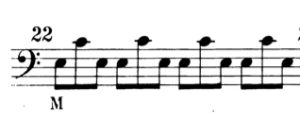
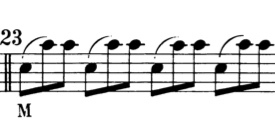
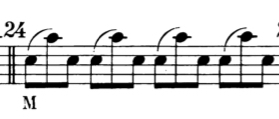
These variations continue with the general themes that Tristan is working on: string crossings (upper arm) and detaché (lower arm), with vibrato. As always, the students play the entire variation in the lessons – I have just cut them short here in the videos.
Someone reading these Blogs recently emailed me asking how much time I spend on these variations in each lesson. I usually divide the lessons into four parts: scales and arpeggios (about 10-15 minutes), Feuillard bowings or other exercises (10-15 minutes), etudes (about 15 minutes) and repertoire (about 15 minutes). Towards the end of the semester I spend more time on the pieces as the students prepare for their semester recitals, but I still try to get at least a few minutes for the other parts of the lesson. Students are expected to play the scales, arpeggios and the pieces from memory, and often the etudes as well. My philosophy is to work on pieces that are easier than the technique that the students have acquired – so a lot of the learning process for the pieces has to happen at home. Then I can just make sure that they are being memorized, and work on any difficult spots, intonation, sound, and style. I usually focus on a few things in the time we have – and expect that the students will practice those things and come back with them well learned.
Bow Changes
In addition to the Feuillard exercises, there is so much additional information about the bow which needs to be covered. For example, teachers must make sure that they discuss techniques such as collé, bow speed, dynamics, etc. I will often work with the students on bow changes at different points in their studies, and throughout the repertoire. In these videos I worked with Tristan on finding circular motions in his bow changes – related to the circles that we are exploring with string crossings:
Another technique that is related to the work Tristan did on his bow changes is what I sometimes call “Three Dimensional Bowing”. This means doing multiple waves on one string with the fingers. It results in a sound that has more “depth” and color. It also can turn into a “bow vibrato”:
Tristan now needs to add fingers to the wrist motion so that the bow does not wobble. The rule, that we saw in the last Blog, was: “When the wrist goes up, the fingers go up; when the wrist goes down, the fingers go down”
Another circular motion that can be useful for bow changes involves the rotation of the stick. This motion is controlled by the third finger on the bow (see my Blog #4 discussing the “Function of the Fingers on the Bow”). This rotation motion of the stick results in an alteration of the hairs that are in contact with the string from one side of the bow to the other.
Work on bow changes is another “life-long” occupation in trying to get smooth, connected, legato bow changes. There are lots of “metaphors” for thinking about bow changes: imagining the hairs of a paint-brush, thinking about the sides of the strings, using various circular motions, imagining waves in the fingers and hands, and of course just listening to the sound of the bow changes and making appropriate adjustments.
Bow Speed
Another topic that needs to be addressed separately from Feuillard is bow speed. One exercise I like to use to sensitize awareness of bow speed is from Paul Tortelier’s book “How I Play, How I Teach”:

One of the issues to pay attention to here is that as the bow speed gets faster the contact point must get higher (the old rule: “The faster the bow speed the higher the contact point”).
Tortelier has another variant of this exercise in his book, which mixes up the bow speed for each note. These exercises are fun to do together with the entire cello class. Sometimes I pull the different meters from a hat and ask them to play whatever random order emerges:
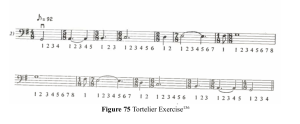
Variation #25:
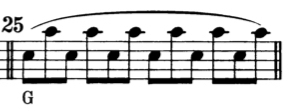
Back to Feuillard: Variation #25 is another one of the wave motions that build on all of the bowing figures and the wrist and finger exercises that we have explored (Blog #20 in this series), as well as the “2,2,2 Exercise” (Blog #21). When Tristan did the “2,2,2 Exercise” we were working on two waves for each part of the arm: the fingers, wrist and upper arm. That exercise divided the bow into three parts for the three parts of the arm. For Variation #19 and now Variation #25 the division is not quite so clear, since there are four beats in the measure. But it should still start with the fingers at the frog, then move into the wrist and fingers towards the middle of the bow, and finally using the upper arm at the tip – if the tempo is not too fast! If the tempo is faster the wave motion will be executed more with the fingers and wrist/fingers.
The other issue with Variation #25 is to feel the triplet rhythm. That means putting a slight pulse on the first note of each group, rather than on every D-string note, which would make it sound like eighth notes.
The wave motion with the wrist is still a bit of a “work-in-progress” for Tristan. I find that students often have an easier time with either the wrist or with the finger motion. In Tristan’s case he finds the “up” motion with the wrist to be his biggest challenge, and he is continuing to work on this. Hopefully by the time we reach the much faster waves in Variations #39 and #40 he will feel comfortable enough with the wrist and finger motions to execute them easily.
Next week’s Blog will start a series of variations using 16th note rhythms, with detaché and legato strokes, along with string crossings on two strings.
*If you have questions or comments about The Joy of Feuillard, Dr. Robert Jesselson can be reached directly at rjesselson@mozart.sc.edu.
Subjects: Repertoire, Technique
